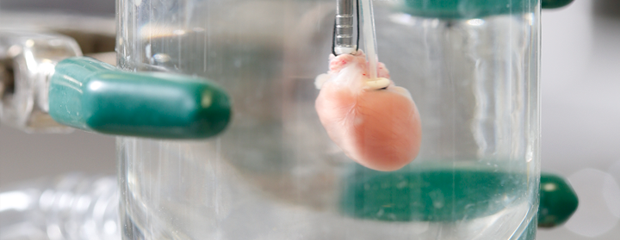

Grants
The Foundation for Heart Science has supported several projects related to this specific clinical problem:
The Foundation for Heart Science awarded a grant to Dr. Jessica Olson at The Institute for Health and Equity at the Medical College of Wisconsin for work that tested an existing therapeutic to limit the progression of cardiovascular disease after radiation treatment for cancers below the diaphragm. Radiation is a cornerstone of successful cancer treatment, with one-half to two-thirds of all patients receiving radiotherapy. Survivors of cancer treated with radiation are at increased risk for heart disease. Understanding how radiation causes heart disease will allow for novel therapies to be developed. Simvastatin, an inhibitor of cholesterol production in the liver, has been used for several decades to decrease cholesterol levels in patients at risk for heart disease, and has been shown to decrease heart disease in animals exposed to lower body irradiation.
Dr. Olson examined the medical records in over 3,600 patients following therapeutic irradiation of cancers below the diaphragm. She found that 47.4% of patients age 70-80 developed heart disease after radiation treatment compared to just 29.7% who received radiation and simvastatin. This study suggests simvastatin can be developed to mitigate and treat heart disease after therapeutic radiation.
The Foundation for Heart Science awarded a grant to Dr. Amy Kronenberg at Lawrence Berkeley National Laboratory. Survival in childhood cancer patients is increasing, but those who were treated with radiation are at increased risk for premature heart disease caused by this treatment.
There is an urgent and immediate need for practical therapies to mitigate radiation injury to the heart. Development of a new drug takes enormous time, money and effort, and can take up to twenty years for use in patients. The repurposing of an approved drug will greatly simplify its development for this purpose.
Dr. Kronenberg's study focused on injury to the non-targeted heart as the result of intentional or unintentional irradiation of organs below the diaphragm. Preliminary studies have shown that simvastatin mitigates against increased risk and severity of cardiac disease following lower body irradiation in animal and human studies. Statins can be repurposed as a medical countermeasure to mitigate injury to the non-targeted heart after irradiation of organs below the diaphragm. Since statins are approved by the FDA for other clinical indications and are widely-available as oral formulations, there is great potential to quickly translate these findings to clinical settings to treat radiation toxicity to heart.
The Foundation for Heart Science awarded a grant to Dr. Christopher Olsen in the Department of Pharmacology at the Medical College of Wisconsin to investigate the damaging effects of radiation on the brain and to improve methods to assess cognitive functioning after cranial radiotherapy. Patients treated with radiation therapy for brain tumors demonstrate a decline in cognitive function that is associated with decreased quality of life. There is a critical need to reduce the late effects of radiotherapy in normal brain tissues, which cause lifelong damage to the brain. The nature of these injuries is not completely understood, hindering the development of protective strategies. Success in preserving normal brain function can improve quality of life and extend survival. The development of interventions to preserve brain tissue and function after therapeutic radiation could eventually be applied to the heart and other organs in this setting.
The Foundation for Heart Science awarded a Postdoctoral Fellowship Grant to Dr. Lam at the Medical College of Wisconsin for work that identified intestinal bacteria as indicators of prior radiation exposure. This project arose from the need for rapid, accurate and sensitive tests to confirm exposure to radiation and estimate the dose absorbed. Clinical symptoms and physical dosimeters, even when available, do not provide adequate diagnostic information to identify individuals exposed to radiation, so that life-threatening injuries can be medically treated in the setting of, for example, a nuclear accident. Bacteria that live in the human intestines are sensitive to radiation. Dr. Lam was tasked with identifying and developing intestinal bacteria that could be used as novel biomarkers for prior radiation exposure. Measurements could then be made on routine fecal samples using readily available machines that can be operated in the field by a medical technician.
Dr. Lam's studies showed that high doses of radiation profoundly change the composition of intestinal bacteria, with the effect persisting for several weeks. The use of intestinal bacteria as biomarkers of radiation exposure is noninvasive and can be developed as a diagnostic tool. The methods Dr. Lam developed led to the discovery that intestinal bacteria are linked to the severity of heart attack in rats.
The Foundation for Heart Science awarded a grant to Dr. Richard Britten at Eastern Virginia Medical School to support his work investigating the damaging effects of space radiation on cognitive functioning in rats. There is a critical need to understand both early and late effects of space radiation on normal brain tissues, which could cause lifelong damage to the brain. Astronauts traveling to Mars and beyond could encounter radiation disruptive to brain function, which could compromise executive functioning of the brain.
The concern is that exposure to space radiation could interfere with critical decision-making abilities in deep space. The nature of injury to the brain from space radiation is not completely understood, hindering the development of preventive strategies. Success in preserving normal brain function is critical to mission success in astronauts. The development of interventions to preserve brain tissue and function in astronauts exposed to space radiation could eventually be applied to the heart and other organs in the setting of therapeutic radiation for cancer.
